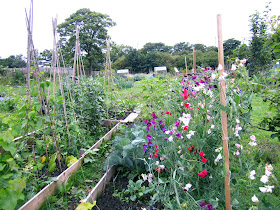I have been reading a bit about preserving, combining salts, sugars and spices to make cuts of meat or vegetables last for months or years. It comes from the days before refrigeration, and although I don't have that problem I still think it is a good way of cutting down on waste if you have too many vegetables or cuts of meat that aren’t perhaps the best. I already need to plan what to do with the millions of courgettes that have begun to appear at the allotment, and am thinking about a courgette, apple, raisin and chilli chutney. So I have been interested to see how difficult it would be to make my own salami, a homemade air dried sausage... It turns out it's not that difficult if you have the right equipment... I'm already planning bresaola and potted shrimp as my next challenge...

Start with a pork shoulder on the bone, I used rolled, but I think getting the meat sinew and fat free might be easier with a boned shoulder. My joint weighed about 1 kilogram and I ended up with about 700g of chopped meat. You also need 200g of back fat, I was told by the butchers in the Grainger Market that you can't get it, I still haven’t worked out why, but he gave me a load of fat they had trimmed from another piece of pork, it was a bit short on weight, but hopefully it will be enough. I have since been to various butchers and found it really easy to get hold of if you ask in advance.
Slice the pork shoulder into pieces, discarding all fat and sinew, and then dice it so you end up with 1cm cubed pieces of meat, or smaller. This process takes a while, my knives weren't sharp enough and it did test my patience... but I persevered and got there eventually. When the pork meat is done also dice the back fat into small cubes of a similar size.
It is now time to salt the meat. I decided to do two different types of salami so I divided my meat into two bowls, half the meat and half the fat in each. The amount of salt is critical for the curing process, so you should weigh everything very accurately. You must add at least 25g of salt to every kilogram of meat. Each of my bowls weighed 422g so I added 10.5g of salt to each, Maldon sea salt that I crushed finely in a pestle and mortar.

Now it is time for the flavouring. I decided on one quite simple combination of half a teaspoon of fennel seeds, half a teaspoon of black pepper corns and a clove of garlic, all crushed to a paste in the pestle and mortar. The other became a bit more adventurous and also perhaps more French in style, with red wine and walnuts. I added half a teaspoon of black pepper corns, a couple of crushed juniper berries, a clove of garlic, again crushed to a paste and added to the meat, along with a handful of chopped walnuts and a splash of red wine. I mixed both of the bowls up to combine the meat, salt and spices thoroughly and put them in the fridge to mingle for a few hours.

Next comes the stuffing. I ordered 38mm natural hog casings for the job, a salted pig's intestine, and soaked them overnight to remove the salt and soften them up. They come bunched up tightly on a tube ready to pull off and pipe in the sausage stuffing. They don't smell very nice I warn you... If you have a mincer they often have a sausage stuffing attachment, or you can use a small sausage funnel or pack it by hand. I did not really have the correct tools for the job, lots of frustration ensued... It took a while to get the salami packed tightly without air gaps and lumps, but I got there finally and ended up with 6 salami in total. I tied up each end with string, tying the intestine into the knot so it doesn't slip through when you hang it. I have found on further attempts that cutting a length a bit longer than you need and stuffing by hand to be the easiest method.

Each salami needs to be labelled with its full ingredients and also its weight. This is important as you will know when the salami is ready when it has lost 30% of its total weight. Hang them inside for a few days while the skins dry out and tighten up. Then hang them either outside in a cage so wildlife can't get to them, and under shelter or in a draughty porch or garage. Mine are currently up in the roof of my porch... it smells quite meaty and garlicky every time I come in and out of the house...
So that is where I am at, they will be ready in 3 weeks, and I'm already looking forward to them. They may start to develop a dry white mould on the outside of the skin, which is ok, but patches of fur or coloured mould should be washed off as they develop with a weak solution of vinegar in water. I will let you know how they taste in due course...
And finally here is the finished article... It was better than I could ever have hoped, really delicious. Rich and deep meaty flavours. When I get some better equipment I will be starting on the next batch...
























